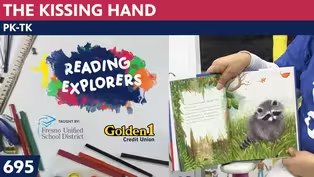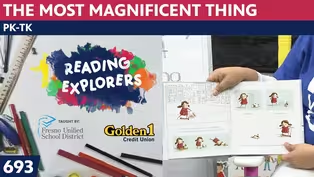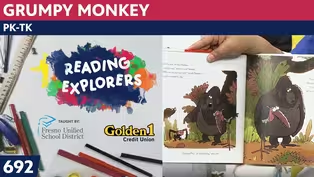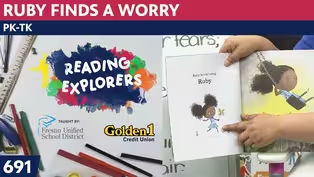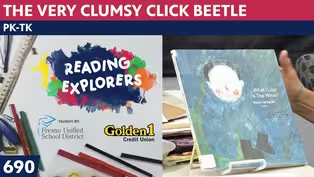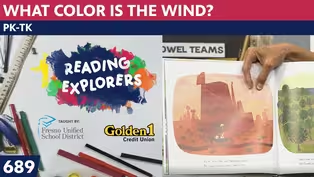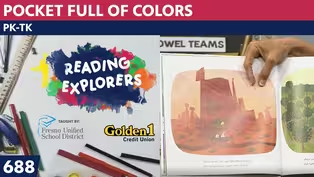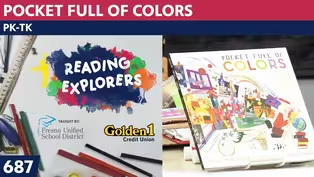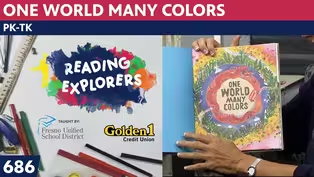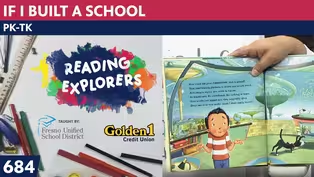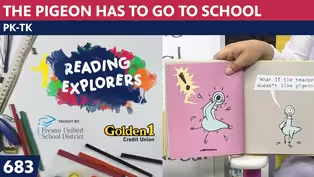
TK-373: Marc Chagall - Russian Village
Season 3 Episode 409 | 14m 13sVideo has Closed Captions
Today's art is "Russian Village" from Marc Chagall
Join me today as we continue our study of one of my favorite artists, Marc Chagall.. Each day we will enjoy a Chagall masterpiece that shows his dreamlike art. Today's art is "Russian Village" We will create art that shows a village that is associated with Chagall's love for his hometown in Russia. If you would like to create a colorful village, bring black paper, oil pastels, a paper towel and
Problems playing video? | Closed Captioning Feedback
Problems playing video? | Closed Captioning Feedback
Reading Explorers is a local public television program presented by Valley PBS

TK-373: Marc Chagall - Russian Village
Season 3 Episode 409 | 14m 13sVideo has Closed Captions
Join me today as we continue our study of one of my favorite artists, Marc Chagall.. Each day we will enjoy a Chagall masterpiece that shows his dreamlike art. Today's art is "Russian Village" We will create art that shows a village that is associated with Chagall's love for his hometown in Russia. If you would like to create a colorful village, bring black paper, oil pastels, a paper towel and
Problems playing video? | Closed Captioning Feedback
How to Watch Reading Explorers
Reading Explorers is available to stream on pbs.org and the free PBS App, available on iPhone, Apple TV, Android TV, Android smartphones, Amazon Fire TV, Amazon Fire Tablet, Roku, Samsung Smart TV, and Vizio.
Providing Support for PBS.org
Learn Moreabout PBS online sponsorshipMore from This Collection
Valley PBS and Fresno Unified School District have partnered with Golden 1 Credit Union to create Reading Explorers Lessons for grades Pre-Kindergarten through Third grade. The daily lessons will be taught by Fresno Unified School District teachers and are created to help students practice their reading skills and reinforce lessons during distance learning.
Video has Closed Captions
Valley PBS presents Reading Explorers Lessons for Pre-Kindergarten and TK. (26m 27s)
PK-TK-693-The Most Magnificent Thing
Video has Closed Captions
Valley PBS presents Reading Explorers Lessons for Pre-Kindergarten and TK. (26m 26s)
Video has Closed Captions
Valley PBS presents Reading Explorers Lessons for Pre-Kindergarten and TK. (26m 28s)
Video has Closed Captions
Valley PBS presents Reading Explorers Lessons for Pre-Kindergarten and TK. (26m 28s)
PK-TK-690: The Very Clumsy Click Beetle
Video has Closed Captions
Valley PBS presents Reading Explorers Lessons for Pre-Kindergarten and TK. (26m 22s)
PK-TK-689: What Color is the Wind?
Video has Closed Captions
Valley PBS presents Reading Explorers Lessons for Pre-Kindergarten and TK. (26m 21s)
PK-TK-688: Pocket Full of Colors
Video has Closed Captions
Valley PBS presents Reading Explorers Lessons for Pre-Kindergarten and TK. (25m 58s)
PK-TK-687: Dancing Through Fields of Colors
Video has Closed Captions
Valley PBS presents Reading Explorers Lessons for Pre-Kindergarten and TK. (26m 20s)
PK-TK-686: One World Many Colors
Video has Closed Captions
Valley PBS presents Reading Explorers Lessons for Pre-Kindergarten and TK. (27m 13s)
PK-TK-685: School is Wherever I am
Video has Closed Captions
Valley PBS presents Reading Explorers Lessons for Pre-Kindergarten and TK. (26m 32s)
PK-TK-684: If I Built a School
Video has Closed Captions
Valley PBS presents Reading Explorers Lessons for Pre-Kindergarten and TK. (26m 21s)
PK-TK-683: The Pigeon Has to Go to School
Video has Closed Captions
Valley PBS presents Reading Explorers Lessons for Pre-Kindergarten and TK. (26m 22s)
Providing Support for PBS.org
Learn Moreabout PBS online sponsorship(guitar music) ♪ Good morning to a brand new day ♪ ♪ Time to learn and games to play ♪ ♪ Learning things is so much fun ♪ ♪ Learning is good for everyone ♪ (playful music) - Hello, early learners!
And welcome back to the art room where we are doing a study of Marc Chagall.
Now, if I asked you what makes Marc Chagall so different from others and you say, "Well, he always had animals in his pictures."
And I'd say, "Okay, what else?"
"Some of his things are upside down."
"Mm-hmm, what else?"
"Oh, he would always tell about his village" "Uh-huh, his village in Russia.
That's right."
And he liked to talk about love and maybe there was a chicken in there and people that loved each other sitting on top of the chicken like yesterday.
But today, he uses primary colors in our picture.
I think we better start out with our "Hello" song and move on to the art, ready?
♪ Hello, nice to see you, everyone ♪ ♪ Hello, nice to see you, everyone ♪ ♪ Hello to you, hello to you ♪ ♪ Hello to you, hello to me ♪ ♪ Hello, nice to see you, everyone ♪ If we have time at the end, we'll sing the song about "I and the Village" again, about the woman being upside down, playing the violin.
Today, though, we're talking about Marc Chagall's picture called "Russian Village."
And he used mostly primary colors.
Do we remember that lesson from long, long ago, the three primary colors?
They are red, yellow, and blue.
And we can make other colors by mixing those three colors to make secondary colors, and then tertiary colors by mixing those together, and then bringing in the white and the black to make shades and tints of colors.
But today, I'm going to try and use red, yellow, and blue mostly in the picture.
Let's take a look over at Marc Chagall, our artist, our French-Russian artist, Marc Chagall.
And we know that he worked and lived for 98 years.
He had a wife he met.
Her name is Bella.
And when he went off to France, she stayed in Russia and he missed her so much, and she missed him.
And he said, "Don't you worry.
I'm coming back to marry you."
And here is one of the Russian village pictures he talks about.
So what we're going to do is do the same thing that happens here.
You see the buildings, none of them are upside down today.
Here is the church at the end of the road.
The road is red, one of the primary colors.
This house is red, and it has a yellow front, and it has a dark roof that's made of blue mixed darker with black.
There is a paint pot on top of this roof.
There's someone working in the garden here.
Here's a villager walking past.
Here's one of our animals in the foreground, that's eating the grasses that are here behind just a single fence.
That animal could get out and roam wherever it wanted to.
And what we're going to do today is use our pastels, our oil pastels, and make them super bright.
And here you can see they made the rocks look like they were colorful too.
If you like using the primary colors, you can do that along with me.
I can see here that they mixed a little yellow with red, and made the orange.
Here's a blue house.
Here's a house that has a blue side but a yellow front and a yellow roof.
So we can make our houses however we would like.
But I'm going to direct draw with you today.
So let me set my things down and pick up my table, and we'll get started with our pastels.
Now, just like I've told you in the past, if you don't have an art material that I'm talking about, then you will use your crayons or you will use something else that you can color with.
So let me put this table on here and notice, I've talked to you about this.
This is just a piece of newspaper, one whole section.
And I taped it across the top, down the side, and this side, and it makes a pad.
Because the oil pastels are very soft.
And when you press on them, they will get even brighter as you press harder.
So I'm going to put this...
Even though it doesn't fit completely under my paper very well, I'm just going to move it around and kind of fix it that way.
Just like yesterday, we started out with a horizon line.
And you can see all of my pastels are a little messy and broken.
So that doesn't matter because they still work really well.
So I'm going to start out with my brown pastel to make a good horizon line.
So I'm going to make...
I think I was just going to make it a pretty big hill.
So I'm going to push down hard.
And I can outline this at the end.
That's one of my suggestions at the end.
You might want to outline something that gets a little smeary.
So now I'm going to make a blue house starting out just like I told you before.
And I'm making it go rectangle, trapezoid.
Diagonal line up, up and across.
I'm going to make this show up better by making my windows white so that you can see this better.
Because once I color it in, I think you'll be able to see it a little better.
But I'm going to make the front of my house blue.
Broke my pastel right off the bat.
I'm pressing kind of hard, going down to the horizon line, and going up to the windows, trying not to bump into the white.
Because what happens then is the white smears in with the blue, and it makes it a light blue, which I just did.
But I can go back later and make sure that I have outlined it again.
And I'm going to make the roof yellow.
So I'm going up here and pressing hard, and getting my yellow roof in here.
It's going to be a vibrant color.
It's not gonna have a lot of detail because the kind of art that we're doing today, the details are not very fine details.
It's just so that you get the idea of the village.
So now I'm gonna do another village but I'm going to outline it in white so that you can see it a little better.
Make your village however big you want your houses.
I'm again putting...
I'm putting three windows on this house.
And remember we do an angle up, an angle up and crossover.
This one, I think, I'll put a chimney on here.
I'm gonna turn it so that you can see 'cause I can color it in upside down.
I'm going to use my red.
I'll use my broken one 'cause I think I probably will end up breaking it 'cause I'm pressing so hard on my newspaper pad.
I try and stay away from the white windows because I tell you, if I mix the red with the white, can you call out what color you think that makes it?
That's right, it would be pink.
If I touched that white window with my red... Oh, I did it again.
I think I'm doing it so carefully.
Boys and girls, I'm not going to use a primary color right here.
I'm going to use my green.
I want my roof to be a different color than the one next door.
And I'm going to make this bricky chimney this color.
All right, now I'm going to go around my next house.
But then I want you to... Oh, maybe I'll make the church now.
I'm going to go up and make the steeple.
And put the cross at the top.
Just make it a little bigger so more people can get in there.
And I do like to make it have a rounded doorway.
There we go.
And I can make a little rounded window and a little rounded window.
And I think I'll do this side of my yellow and make it more like an adobe building.
Around and in there.
Well, it looks like a little face.
This looks like the mouth and two eyes.
I'm not sure if I like that but I might be able to change it.
Now, in front, I want us to make some green bushes.
So your bushes can look cloudish, a cloud shape.
And I'm pressing hard and I'm going in a circle around.
This one, I'll make another one, bushes in the front.
We'll put trees in the back, and a path in the front.
And I wanted you to see how using a black paper with pastels makes things pretty bright.
I think I'll use a dark green for the trees in the back.
Oh.
Oh, I grabbed blue when I said green.
I thought it was right next to it.
I'm going to make... Do you laugh each time it breaks?
I just think I'm trying to be careful, but it's so soft.
It just breaks off even if I'm being careful.
Now, I can put the tree branch.
I'm gonna mix it a little yellow with my brown because the brown I found out looks kind of orange to me, so I can mix that in there.
Move off my pieces.
I think I'll put another tree here with my brown, and put the branches up, and put this tree a little more curly.
And I can do that color green.
I can use the darker green on top of it 'cause I don't know how many trees I've seen where there's just one color leaf.
So you decide what you think looks good.
And I've done a blue house, a red house, a church.
I think I'll go around the next one with white so I can see it again.
This one's going to be a tiny house.
Maybe it's someone just where one person lives there.
And I'll put the roof with the trapezoid top.
And I'm gonna put the chimney in the middle of the house.
This one, I think I will put a door, maybe a little round window above.
I wonder how your houses are coming along.
There we go.
Still, I'd moved up to things so that you can see what I'm talking about.
And then I can go back to putting more bushes.
They don't all have to be the same color.
And I might even put one in between here.
I could do one where I mix the dark green and the light green.
So I'm gonna put the light green down first, and then I can put the dark green on top.
Oh, it kind of looks good when I mix those two together 'cause it doesn't make it exactly like the color next door.
I wonder what this house would be good as a purple house.
It would be the tiny little purple house sitting on the hill.
Still trying to stay away from my white so it doesn't make it a lavender, because purple with white mixed together makes it a lavender.
I think this looks pretty good.
I think I'll give this one a roof that is blue.
But I might mix in some light blue, so you can see that it has a little different color than the one way down at the beginning.
And I'll mix this in.
Oh, I think I like that.
It makes it kind of sky blue.
Mixing colors makes it pretty fun.
I think I'll do another smallish one.
I'm cleaning off...
When your pastels get all colorful, and you don't want that next color to go on the next one, just rub it off.
And if you have a paper towel, that makes it good too because then you don't put it on your paper pad, and get it on something else.
Now, I'll make one more village.
And you know, I'm making my lines kind of slanted because the hill is slanted.
I'm doing a trapezoid line.
I'll do this this way so you can see.
I made the rectangle.
I made the trapezoid line up, and another one that goes up the same height so that the roof isn't so crookedy.
I think I'll make it have some shingles, and not even colored in.
It will be a black roof.
He gets to have a door too.
And I'll make it a triangle window.
Triangle windows would not be something people would really put in there 'cause it doesn't let very much light in.
I'm gonna make this a yellow house.
Trying to stay away from the white.
But when it mixes with yellow, it's not as much of a difficulty.
You can still see it 'cause white and yellow are both light colors, and you don't really see the change in that.
It's kind of fun to do something like this and just chat with a friend while you're working on it, because you don't have to think really hard about what you want to draw.
But this is our Russian village.
And I think I will use my pastel on its side.
Boys and girls, when you use a pastel on its side, it's just like when you're shading, and I'm putting the path that goes in front of the houses like that, and I can color it in darker if I want to.
And I can make a fence for if I decide to put a cow in the field or a chicken out walking along the road.
And also I can put the kinds of rocks that they had on the road too.
And I think it's almost time to say goodbye.
So while I keep working, I'll tell you that tomorrow, we're gonna be using a poster of a fish.
And we're going to use that fish and put silver scales on it.
So bring some paper and some pencils.
Bye, boys and girls.
(guitar music) ♪ Good morning to a brand new day ♪ ♪ Time to learn and games to play ♪ ♪ Learning things is so much fun ♪ ♪ Learning is good for everyone ♪
Support for PBS provided by:
Reading Explorers is a local public television program presented by Valley PBS
